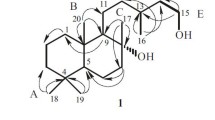Summary
Several α,β-unsaturated and aromatic aldehydes were evaluated for antimicrobial activity usingMycobacterium bovis as the test strain. Activity of most of the compounds was determined in the presence and absence of 2% glutaraldehyde. Several compounds highly active against this organism, e.g. 2-pentenal, benzaldehyde, ando-phthalaldehyde showed rapid kill of >105 CFU ml−1 in 5 min. Activity of α,β-unsaturated compounds substituted in the β1 position showed increasing activity with increasing chain length. Of the aromatic aldehydes tested, benzaldehyde andp-dimethylamino benzaldehyde showed little activity alone, but when combined with 2% glutaraldehyde showed increased activity. Substituents added to the benzaldehyde ring (nitro, chloro, methyl, and methoxy) all detracted from the synergism, but still showed increased activity over the activity of 2% glutaraldehyde. The same affect was noted with disubstituted benzaldehyde compounds but not with substitutedo-phthaladehyde (2-formylformaldehyde).
Similar content being viewed by others
References
Aharoni, Y. and R. Barkai-Golan. 1973. Sensitivity to acetaldehyde vapours ofAlternaria tunuis andStemphylium botryosum. Phytopathol. Zeitschrift 78: 57–61.
Ascenzi, J.M., R.J. Ezzell and T.M. Wendt. 1987. A more accurate method for measurement of mycobactericidal activity of disinfectants. Appl. Eviron. Microbiol. 53: 2189–2192.
Bachrach, U., S. Don and H. Wiener. 1971. Antivirus action of acrolein, glutaraldehyde and oxidized spermine. J. Gen. Virol. 13: 415–422.
Beilfuss, W. 1976. Vergleichende untersuchungen der antimikrobiellen wirksamkeit α,β-ungesattigter aldehyde. Zbl. Bakt. Hyg., I. Abt. Orig. A 234: 271–280.
Boucher, R.M.G. 1975. On biocidal mechanisms in the aldehyde series. Can. J. Pharm. Sci. 10: 1–7.
Burton, D.E., K. Clarke and G.W. Gray. 1964. The mechanism of the antibacterial action of phenols and salicylaldehydes. Part III. Substituted benzaldehydes. J. Chem. Soc. July (1964): 2458–2460.
Chan, K. and T.M. Lau. 1979. Effect of formaldehyde on oxygen uptake and β-galactosidase activity inEnterobacter aerogenes. Microbios. Lett. 10: 69–74.
Cole, E.C., W.A. Rutala, L. Nessen, N.S. Wannamaker and D.J. Weber. 1990. Effect of methodology, dilution, and exposure time on the tuberculocidal activity of glutaraldehyde-based disinfectants. Appl. Environ. Microbiol. 56: 1813–1817.
Collins, F. (1986). Comparison of bactericidal activity of alkaline glutaraldehyde solution against a number of atypical mycobacterial species. J. Appl. Bacteriol. 61: 247–251.
Dabrowa, N., J.W. Landau and V.D. Newcomer. 1972. Antifungal activity of glutaraldehyde in vitro. Arch. Dermatol. 105: 555–557.
Dennis, C. and A. Gaunt. 1974. Effect of formaldehyde on fungi from broiler houses. J. Appl. Bacteriol. 37: 595–601.
Egyud, L.G. 1967. Studies on cell division: the effect of aldehydes, ketones and α-keto-aldehydes on the proliferation ofEscherichia coli. Curr. Molec. Biol. 1: 14–20.
Gorman, S.P. and Scott, E.M., 1977a. A quantitative evaluation of the antifungal properties of glutaraldehyde. J. Appl. Bacteriol. 43: 83–89.
Gorman, S.P. and E.M. Scott. 1977b. Transport capacity, alkaline phosphatase activity and protein content of glutaraldehyde-treated cell forms ofEscherichia coli. Microbios 19: 205–212.
Gorman, S.P. and E.M. Scott. 1977c. Effect of alkalinization of the bacterial cell and glutaraldehyde molecule. Microbios. Lett. 6: 39–44.
Gorman, S.P., E.M. Scott and A.D. Russell. 1980. A review. Antimicrobial activity, uses and mechanism of action of glutaraldehyde. J. Appl. Bacteriol. 48: 161–190.
Jarlier, V. and H. Nikaido. 1990. Permeability barrier to hydrophilic solutes inMycobacterium chelonei. J. Bacteriol. 172: 1418–1423.
Kremzner, T.L. and D.H. Harter. 1970. Antiviral activity of oxidized polyamines and aldehydes. Biochem. Pharmacol. 19: 2531–2550.
Major, R.T., P. Marchini and A.J. Boulton. 1963. Observation on the production of α-hexenal by leaves of certain plants. J. Biol. Chem. 238: 1813.
McGucken, P.V. and W. Woodside. 1973. Studies on the mode of action of glutaraldehyde onEscherichia coli. J. Appl. Bacteriol. 36: 419–426.
Munton, T.J. and A.D. Russell. 1970. Aspects of the action of glutaraldehyde onEscherichia coli. J. Appl. Bacteriol. 33: 410–419.
Munton, T.J. and A.D. Russell. 1973. Effect of glutaraldehyde on the outer layers ofEscherichia coli. J. Appl. Bacteriol. 35: 193–199.
Munton, T.J. and A.D. Russell. 1973. Effect of glutaraldehyde on cell viability, triphenyltetrazolium reduction, oxygen uptake, and β-galactosidase activity inEscherichia coli. Appl. Microbiol. 26: 508–511.
Oh, H.K., T. Sakai, M.B. Jones and W.M. Longhurst. 1967. Effect of various essential oils from Douglas fir needles upon sheep and deer rumen microbial activity. Appl. Microbiol. 15: 777–784.
Pepper, R.E. and V.L. Chandler. 1963. Sporicidal activity of alkaline alcoholic saturated dialdehyde solutions. Appl. Microbiol. 11: 384–388.
Rehn, D. and H. Nolte. 1979. Zur antimikrobiellen wirksamkeit substituierter aromatischer aldehyde und alkohole. Zbl. Bakt. Hyg., I. Abt. Orig. B 168: 507–516.
Sabel, F.L., A. Hellman and J.J. McDade. 1969. Glutaraldehyde inactivation of virus in tissue. Appl. Microbiol. 17: 645–646.
Scaife, J.F. 1970. Modification of the cytotoxic action of hydroxypentenal on cultured mammalian cells. Naturwissenschaften 57: 250–252.
Schauenstein, E. 1967. Autoxidation of polyunsaturated esters in water: chemical structure and biological activity of the products. J. Lipid Res. 8: 417–428.
Schauenstein, E., J. Zangger and M. Ratzenhofer. 1964. Uber die wirkung von hydroxyoctenal auf Ehrlich-acites-tumorzellen. Z. Naturforsch. 19b: 923.
Author information
Authors and Affiliations
Rights and permissions
About this article
Cite this article
Gordon, M.D., Ezzell, R.J., Bruckner, N.I. et al. Enhancement of mycobactericidal activity of glutaraldehyde with α,β-unsaturated and aromatic aldehydes. Journal of Industrial Microbiology 13, 77–82 (1994). https://doi.org/10.1007/BF01584102
Received:
Revised:
Accepted:
Issue Date:
DOI: https://doi.org/10.1007/BF01584102




